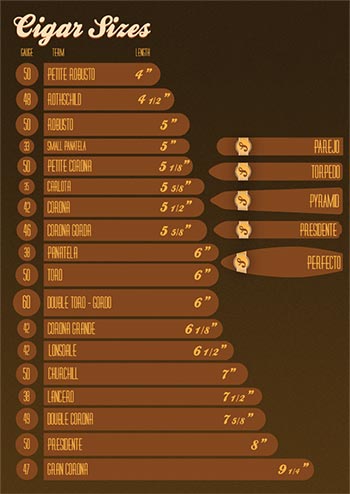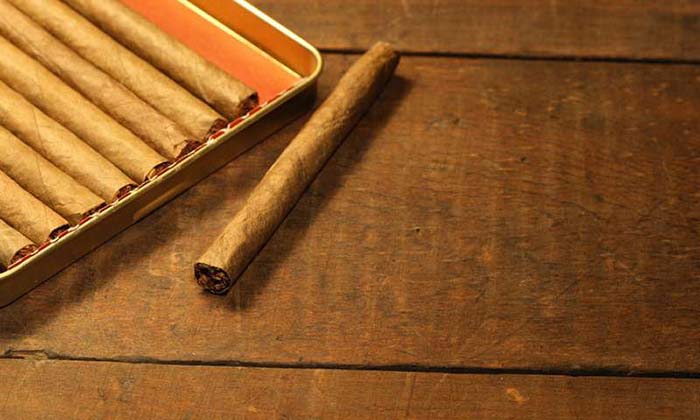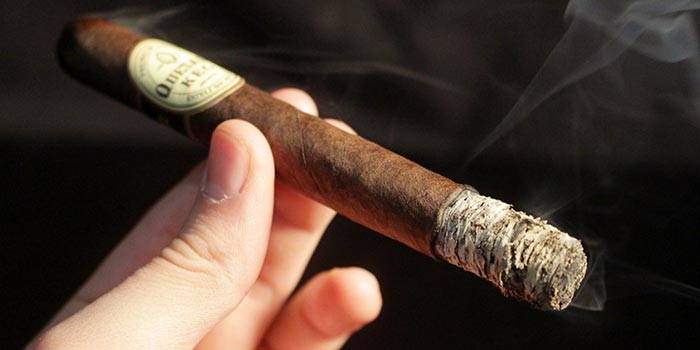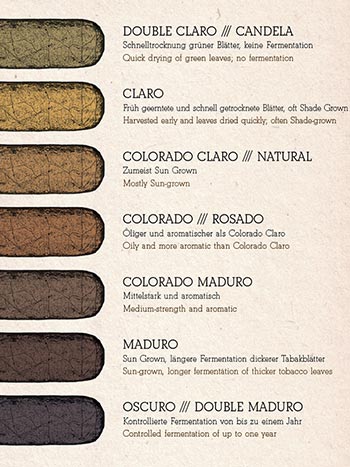Cigar Sizes: A Size & Shape Guide For All Cigars
The first cigar factory started its production in Cuba in 1541, and they reached Europe in 1717. In the second half of the 18th century, the French and Germans learned how to make cigars, and a little later people mastered their production in the USA.
Then, in the middle of the 19th century, more than 800 brands were produced in Havana alone. And, of course, to understand such an abundance of products, you need to be a bit of an expert. In addition to aromatic and taste characteristics, there are several criteria you need to be aware of when choosing cigars—especially when there are so many options, like Gurkha.
In this cigar sizes guide, we will talk about what a cigar is and what the various types are. You will learn about the various sizes and shapes, and the differences between them. We will also describe the most popular forms and talk about the color of wrappers.
What Is A Cigar?
A cigar is a three-part tobacco product, containing:
- Filler, made from crushed tobacco leaves
- A binder leaf that allows you to shape the stick
- A wrapper
The filler is most often a mixture of several varieties of tobacco leaves, cut into strips. Most often, manufacturers include three types of leaves in the blend: upper (for the strength), lower (allowing combustion), and light (used for aroma and flavor).

The binder leaf has to give the product the required shape, so it should be strong enough and resilient. In machine-rolled cigars, it may be completely absent. Experts call these types of cigars cigarillos. The smell of the blinder leaf is not very important.
The wrapper not only allows you to give the product an original appearance but also adds additional “shades” to the taste and aroma.
A finished product contains four parts: the head, the cap, the foot, and the body. It’s important to note that hand-rolled cigars always have an enclosed cap. Therefore, you need to cut off a piece of the cap itself in order to smoke it. If the twisting is carried out by the machine, then they’re most often ready for use right when you make your purchase. That is, they either have a hole or are already cut.
The center part is the body. There is a band close to the head, where the manufacturer places a band with their brand or some unique image. The foot is on the opposite end of the product head – you bring fire to it when lighting the cigar. The foot has an open cut.
What Are Common Cigar Sizes & Cigar Shapes?
Each cigar has its size (length and diameter) and shape. Together, these indicators have name “Vitola“, which is the word typically used by manufacturers that means the shape. There can be many different sizes and shapes of a cigar. However, in practice, the manufacturers use only a couple of hundreds of Vitolas. Only about fifty of them are traditional.
A specific part of these traditional Vitolas have become generally accepted, and they are called classic. You can find Vitolas of some brands, which are produced only by this company. On the other hand, there are Vitolas that every manufacturer has to provide.

In Cuba, for example, the state standardization controls production. The total amount of Vitola types produced varies between 50 and 80.
The Many Sizes of Cigars Explained
Manufacturers usually show the length of the cigar in inches (1 inch = 2.54 cm). Although, in some countries, sellers convert inches to centimeters, or millimeters. It is not convenient since the history of the creation and production endowed them with relatively easy to remember sizes in inches – 4, 4.5, 5, 5.5, 6, 6.5, 7, etc.
The unit used to measure the diameter is called the ring gauge. Companies borrowed it from jewelers. One ring gauge is equal to 1/64 inch (or approximately 0.396 mm). To understand this better, let’s look at the following example. Say you see a cigar marked with the following size: 5×64. The first number shows the length to be 5 inches. The ring being “64” means that the cigar has a ring size (diameter) of 64/64, or 1 inch/2.54 cm. The most common ring gauges 38, 42, 46, 50, and 52.
Products with a big ring have a stronger taste; they burn slowly and evenly. Many true cigar lovers believe that caliber should be the basis for their selection. However, they should not also neglect the length since the dynamics of the development of taste depend on it.
There is a very conditional division into the following groups, which depends on their ring size:
- Thin – ring gauge of 26-39
- Medium – ring gauge of 40-44
- Thick – ring gauge above 45
Manufacturers usually indicate the size of their cigars in the following way: 5×50, 4.5×60, 6×45, etc. The classic Corona size, for example, is 6×42. Following the example given above, this means the cigar is six inches long and 42/64ths inches in diameter.
Most Common & Popular Sizes of Cigars

Small Sized Cigars
- Demi-Tasse – 3 1/8 x 30 (100 mm x 11.91 mm)
- Chicos – 4 1/8 x 29 (106 mm x 11.51 mm)
In addition to their small size, these cigars also consist of a specific mixture of tobacco leaves.
Medium Sized Cigars

- Petit Coronas – 5 x 42 (129 mm x 16.67 mm)
- Coronas – 5 1/2 x 42 (142 mm x 16.67 mm)
- Robusto or Rothschild – 4 1/8 x 50 (124 mm x 19.84 mm)
Petit Coronas is a highly popular cigar. Due to its small size, it smokes quickly and easily. Usually, this type is excellent to smoke in the morning. Coronas are the most common size. They are easy to handle, and they burns for about an hour.
Robusto, also known as Rothschild, is a size that covers the market of experienced smokers. It has a reduced smoking time. But due to its diameter, it gives a fabulous aromatic strength, which can be too strong for a beginner.

Large Sized Cigars
- Lonsdale – 6 1/2 x 42 (165 mm x 16.67 mm)
- Belicosos – 5 1/2 x 52 (140 mm x 20.64 mm)
- Piramides – 6 1/8 x 52 (156 mm x 20.64 mm)
Lonsdale’s were produced for the British Lord Lonsdale, and is more elegant than Double Corona or Churchill. Belicosos are cone-shaped. Piramides is similar to Belicosos, but they are bigger and have a sharper end.
Cigar Shapes Explained
The main two cigar shapes commonly found in stores are Parejo and Figurado.
Parejo, or straight cigars, are most common shape currently available. These are cylindrical sticks with a closed head and an open foot. Cigars of this type differ in length and ring gauge size. The modern ‘classical’ forms of Parejo are Giant, Demi-Tasse, Corona, Lonsdale, Panatela, Robusto, Cigarillo, Toro, and Churchill.
Historically, the original Vitola of the cigar was Corona. Over time Panatela (a longer, but thinner cigar) became popular. Then, many varieties of the Coronas and Panatelas appeared and came into use. Manufacturers include some of them in the category of modern ‘classical’ shapes.

Figured cigars (Figurado) have their specific shapes. An example of this would be pyramids or torpedoes. The main Figurados are Diadem, Torpedo, Pyramid, Belicoso, Perfecto, and Culebra.
- Diadema – closed ends on both sides. The narrowing to the cigar head is smooth, while the cigar foot is much sharper.
- Pyramid – a cylindrical stick with a narrow head and an extended foot.
- Torpedo – thickened body that gradually narrows to both ends.
- Belicoso – usually short, very similar to a torpedo, but with a pointed head.
- Perfecto – closed pointed head, a thickened body, and a conical, sometimes closed or cut off foot.
- Culebra – a peculiar and exotic cigar, consisting, in fact, of three cigars (usually Panatelas) twisted like a snake. Culebra, translated from Spanish, means snake or serpentine.
Shapes Of Cigars Named After People In History
We should note that some classic cigar shapes got their names in honor of their famous admirers.
For instance, a “Churchill” shape got its name from the Prime Minister of Great Britain Winston Churchill. It was the cigar of this shape that Winston Churchill preferred to smoke.
The London financier Leopold de Rothschild also immortalized himself in his chosen style—a thick but short cigar. A Vitola Rothschild is similar in size to Vitola Robusto. It is practically the same Vitola, which some call Rothschild and others Robusto.
What Does The Color Of My Cigar Mean?
A classification guide would not be complete without this characteristic. When talking about the various colors, this is in reference to the color of the cover leaf. Previously, manufacturing companies operated on dozens of terms to indicate the shades of the wrapper. Today, most of them have reduced the number of commonly used colors to 10.

There are seven basic ones that describe tobacco leaves grown in Nicaragua, Honduras, Ecuador, etc. So, let’s move on to their descriptions:
- Claro – light green leaf obtained by steaming tobacco so that it saves the chlorophyll. Leaves are light brown and have a slightly sweet taste. Farmers get it when growing tobacco under tents. The wrapper does not change the taste, for which manufacturers and connoisseurs appreciate.
- Natural – light brown leaf. Such tobacco is grown openly in direct sunlight.
- Colorado – brown leaf that may have a reddish tint.
- Colorado Maduro – cross between Colorado and Maduro.
- Maduro – leaf with an original tobacco dark brown color.
- Oscuro – dark brown leaf, almost black. This tobacco stays on the plantation longer than others, and after picking, it undergoes fermentation and aging.
Thus, all wrappers consist of two categories:
- Sun Grown – those that are grown in natural conditions, without protection from sunlight and have a darker color
- Shade Grown – leaves grown under covers with varying degrees of transparency, which are smooth and have a soft texture
Wrapping It Up
As you can see, all of the different cigar shapes and sizes can drive you crazy when you’re not 100% sure what each thing means. There are many types that all differ in shape, size, color, and taste. All of them have their unique features, that is why we love them so much. Hopefully our guide of cigar shapes, sizes, and colors will help you to take a step towards becoming an expert in this industry.

Very helpful for a novice.
Glad you found it helpful, George!
Thanks for mentioning that a good quality cigar that has a light brown color is called the Claro kind which may have a slightly sweet taste. I am actually looking this up since I am looking for a gift to give my dad for his birthday next month. I should shop online and see more information about which brands have the best ratings.
Sizes, shapes, colors are very clearly described in this article. A great buying guide to keep for future reference. A must for the inexperienced cigar shopper! Thanks!!